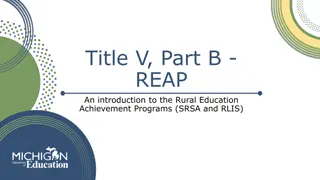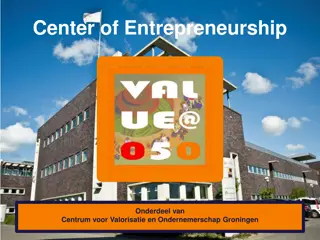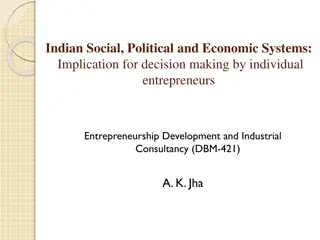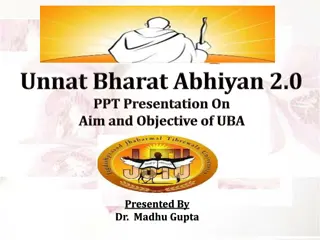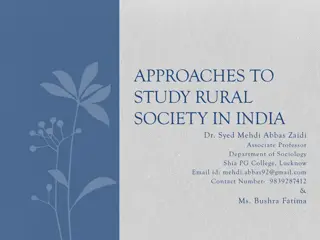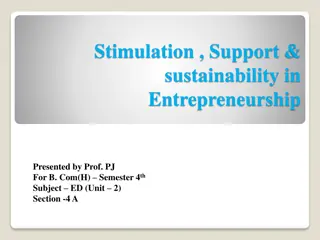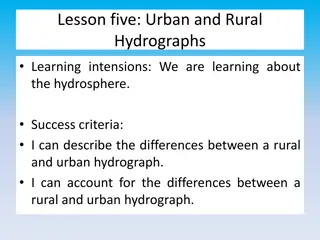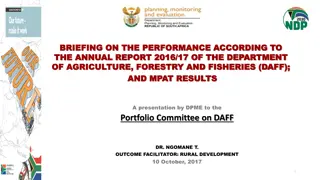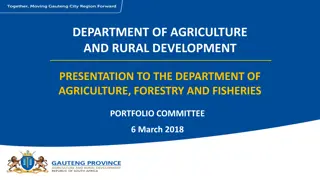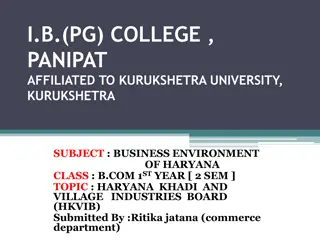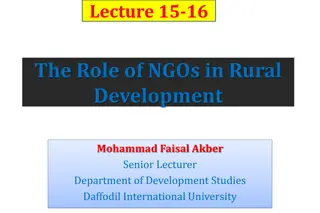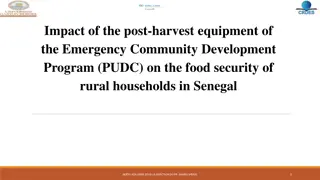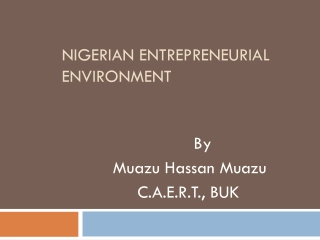Rural Entrepreneurial Transformation: A Study on Indian Handmade Paper Industry
The Indian Handmade Paper Industry, recognized as a traditional craft, has shown remarkable growth over the years, providing employment opportunities to rural artisans. Despite its qualities, the industry faces challenges in marketing and reaching its full potential in the global market. Understanding consumer behavior, quality, price, availability, and promotional strategies are key factors in promoting handmade paper products effectively.
Uploaded on Sep 11, 2024 | 0 Views
Download Presentation

Please find below an Image/Link to download the presentation.
The content on the website is provided AS IS for your information and personal use only. It may not be sold, licensed, or shared on other websites without obtaining consent from the author. Download presentation by click this link. If you encounter any issues during the download, it is possible that the publisher has removed the file from their server.
E N D
Presentation Transcript
International Virtual Conference on Challenges in Education, Business and Technology Center for Academic & Professional Career Development and Research (CAPCDR) RURAL ENTREPRENEURIAL TRANSFORMATION: A STUDY ON INDIAN HANDMADE PAPER INDUSTRY Mr. Rajeev Sinha & Prof.(Dr. )Angad Tiwary
INTRODUCTION "Handmade Paper is layer of entwined fibers held together by the natural internal bonding properties of cellulose fibers lifted by hands, sheet by sheet on moulds in suspension of fibers in water with or without sizing."
INTRODUCTION The Handmade Paper Industry has been recognized as traditional craft of village industry under Khadi& Village Industries Commission (KVIC) Act-1957". KVIC provides special assistance to this industry for the development of rural craft and artisan work. In India it has been developed as cluster based industry. The most effective clusters are situated at Kalapi(Uttar Pradesh), Sanganer in Jaipur(Rajasthan), and Mahaboobnagar( Andhra Pradesh). Apart from these clusters there are some small clusters spread in all over India.
INTRODUCTION In 1953 this industry was having 35 -40 units for production but today after half century hand made paper industry is having more than 3000 production units and increase of 35 times (1991 Rs 6 millions to Rs 210 millions in 1999-2000) recorded in hand made paper industry and its value added items. The Handmade Paper Industry has provided gainful employment to around 18000 direct and indirect people today. Rural artisans are benefited through this industry.
INTRODUCTION The marketing of handmade paper is different than any other goods and products. In spite of, so many qualities and attraction could not reach at the optimum level of its market share. Still in this global era the handmade paper industry does not have systematic and planned marketing strategies for its promotion at a wider level. The wide publicity about the use of handmade paper and its promotion activities will surely increase its acceptability and people habit to use it frequently.
INTRODUCTION In customer survey we have got few factors which influence the consumer's behavior for handmade paper products: Quality of products Price Multiple uses Availability Durability Advertisement and awareness Substitute goods etc.
INTRODUCTION The Indian paper industry can be divided into four categories: i) large-scale (integrated) units - 50,000 tonnes and up per year; ii) medium-scale units - 10,000 to 50,000 tonnes per year; iii) small-scale agro-based units - up to, 10,000 tonnes per year; iv) handmade paper units - 60 to 300 tonnes per year.
Table 1: Country- wise production and consumption of Pulp and Paper in 2010 (MillionMT)
Top 4-Non-Wood pulp Producing Countries( Million Metric Ton in 2014)
LITERATURE REVIEW Sanganeri handmade paper is a exclusive art itself, which have a noteworthy identity. Although it has been changed from time to time it is up till now popular in and outside the country. In the 16th century Sawai Man Singh, the emperor of Amber brought the Kagzis to Sanganer and settled them. Later it became the biggest centre of the handmade paper. Handmade paper is entirely natural paper. (KVIC Report, 1997).
LITERATURE REVIEW Cotton cloth rags, hosiery pieces, silk fiber and banana tree fibers etc the natural raw material which is used to make handmade paper. It is totally chemical free and no acid is used to make this. The natural raw material gives a distinguished strength to the handmade paper (Vivek Kumar,2006). The traditional raw material of handmade paper is obtained from forests. Deforestation and environmental imbalance is immerging as a big problem worldwide. So to overcome this problem cellulosic (non woody) substitutes should be used as raw material.
RESEARCH METHODOLOGY The present study has been conducted in Sanganer, Jaipur, with the objective of - to explore the problems of the handmade paper industry. Sanganer is a major centre of handmade paper manufacturing in India which is situated 15 km far from Jaipur. Twenty factories were selected for the sample. From these factories, 20 owners (owner of each factory) and 40 workers (2 workers from each factory) were interviewed.
RESEARCH METHODOLOGY The list of industries was provided by KVIC. The data was collected through interview and questionnaire method. Personal interview and observation method were used for collecting data. A semi structured interview schedule in two parts was used which was made by researcher - For factory owners and For workers
ANALYSIS OF DATA The answers to every question were coded. After collecting the data the result was obtained by frequency and percentage. Results were obtained into two parts. 1. Results from owners- In this part the problems faced related to this business, changes in product, color, design technology and import- export in last two decades. The facilities provided by the government for this business. And the disposal of waste material during the production etc. was included. 2. Results from workers- Socio economic status of workers, problems related to workplace and facilities provided by owners to the workers were included.
Results from owners Part 1 demographic/basic profile The 45% owners were of ages 40-50 years. 25% owners were of ages 30-40 years and 15% were of ages 20-30years, rest 15% was of ages 50-60 years. This distribution shows that 70% owners were of ages 30-50 years. 45% owners belong to general (Muslim) cast and 55% were from backward (Mali) casts. All of the owners were educated as 50% owners were graduate, 25% were educated at senior secondary level 10% were educated at the secondary level. Only 15% owners were higher (post graduate) educated. Total 20 factories were included in the study, out of them 11 factories had 12-25 workers, 4 factories have 26-50 workers, 3 factories have 51-100 workers and only 2 factories have 101-200 workers.
Results from owners Part 1 demographic/basic profile On the basis of this result, it can be stated that this is a popular family business and most of the owners were involved due to the advantage of family experience. The 75% owners who got this business from family also learnt this art from senior family members. And rest 25% has learnt this art from Kumar Appa Institute. 60% factory owners got trained in1-6 months and 40% got trained in 6-12 months before starting their business. All the owners found this art is very simple to learn and an unskilled worker can easily learn it with few efforts. All the owners train their new workers themselves.
Part 2 this part includes details of problems faced in business. In the establishment of business, almost all owners have few problems. The owners (25%) who started up this business their own faced the problems related the lack of infrastructure- space related. Problems related with the labors were faced by 35% of the owners and rest 40% has market related problems. Although this is a family business of 75% owners so they have only market and workers problems. The 25% owners faced the problem of space and
Facilities provided by the government All the respondents were aware of the tax relaxations provided by the government. But only 45% owners availed the loans at low interest rate. KVIC also provide training to the owners and workers time to time and organize seminars of related activities. All the respondents attended the same and will in future participation. Whereas relaxation/ discounts in electricity rates is a major demand of owners (50%) and raw material at low prices is also desired (by 20% of owners). Remaining 30% of owners want machinery at discounted/subsidized prices.
Method of treatment and management of waste All the interviewed factory owners believe that handmade paper making process is safe for the environment as the raw material used is obtained from natural resources and waste products. These materials do not leave harmful residue. And the colors used in manufacturing are 100% natural and safe. Any harm to environment and workers not found. Edged and pieces left after cutting and finishing of paper sheets and other items are also used as raw material. The results show that the handmade paper making in Sanganer is completely environment and for workers and users natural and safe for the
CONCLUSION The handmade paper is playing a vital role in keeping the environment clean. The people who are aware of environment protection use handmade paper and products with pride. This sector is a victim of several changes in last few decades. Earlier it was simply made up without colors and designs but now it is. Sanganeri handmade paper and products are notonly famous in India but also getting the attention of the entire world as it s demand for export is increasing day by day.
CONCLUSION With the traditional goods like diaries, folders, drawing sheets, it is also used for making lampshades, decorative papers, envelops, pen & mobile stands, cards, flower vases, jewelry boxes, photo frames and different kinds of packaging materials etc. the government of India is helping this industry by providing low interest rate loan, tax exemptions, training programs etc. But this sector needs more attention as it plays a vital role in saving the environment as well as providing employment to the unskilled workers. The industry should be promoted by the government by announcing promotional schemes as well as by advertising the handmade paper products for making it popular.






